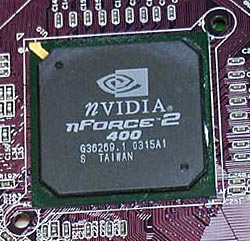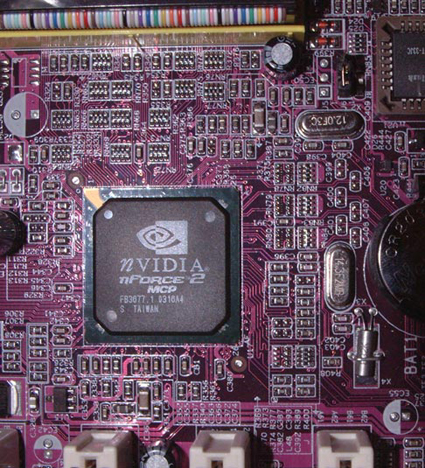Soltek NV400-L64: Purple, Practical, AND Performance!
by Wesley Fink on August 11, 2003 10:26 PM EST- Posted in
- Motherboards
Soltek NV400-L64: Basic Features
| Motherboard Specifications | |
| CPU Interface | Socket-462 |
| Chipset | nForce2 400 Single-Channel North Bridge nForce2 MCP South Bridge |
| Bus Speeds | 100 to 250MHz (in 1MHz increments) |
| PCI/AGP Speeds | Auto (Variable) or Fixed 50-100MHz (in 1 MHz increments) |
| Available CPU Ratios | 5.0X to 22X |
| Core Voltage | 1.10 to 1.85V (in 0.0250V increments) |
| DRAM Voltage | 2.50V to 2.80V (in 0.1V increments) |
| Chipset Voltage | VDD to 1.80V (in 0.1V increments) |
| AGP Voltage | 1.50V to 1.80V (in 0.1V increments) |
| Memory Slots | Two 184-pin DDR DIMM Slots in Single-Channel Configuration |
| Expansion Slots | One AGP 8X Slot Five PCI Slots |
| Onboard IDE | Two Standard ATA133/100/66 (maximum 4 IDE devices) |
| Onboard USB 2.0/IEEE-1394 | Six USB 2.0 ports supported by MCP NO IEEE-1394 FireWire |
| Onboard LAN | nForce MCP 10/100 Ethernet |
| Onboard Audio | Realtek ALC650 codec AC ’97 2.2 Compliant 6-Channel |
| Onboard Serial ATA | None |
| BIOS Revision | Version 1.1 Release BIOS 6/20/2003 |

The Soltek NV400-L64 comes in a slick foil-faced embossed package that is used for many Soltek motherboards. As expected with a value board, extras are a floppy and IDE cable and nothing else. It is worth mentioning, however, that Soltek includes an extra Utility CD with their motherboards that contains PC-Cillin 2002 anti-virus, Farstone’s VirtualDrive 7 and RestoreIT 3 Lite, and Powerquest’s Partition Magic 6.0 SE and DriveImage 4.0. While these are not the latest versions of most of these utilities, they are still utilities that are frequently used. There are two versions of the NV400 listed at the Soltek website. The NV400-L64 and NV400-64 appear the same, except for the 10/100 LAN connection on the NV400-L64, which is the version that we are testing.
Soltek did not use any fancy names for the NV400-L64, but they certainly could have. You can’t help but notice that the board is purple or plum-colored. The purple board is smaller than the full size nForce2 Ultra 400 boards that we have been evaluating, and uses only seven standoffs in two rows for mounting. Full-size boards generally use nine or ten standoffs in three rows for case mounting. This small motherboard should have no trouble fitting into any standard case.

Sound is provided by the common Realtek ALC650 chip, which is compliant with AC ’97 2.2 to provide 6-channel sound. AC ’97 2.2 seems to have replaced older AC ’97 chips, which now makes 6-channel sound mainstream. Audio quality is OK for casual listening or computing, but audio enthusiasts will want to use a separate audio card for top quality. The on-board audio can be disabled in the BIOS if you wish to use a separate audio card. Only the three standard output jacks are provided for audio input and output on the I/O panel, but software that comes with the NV400-L64 does allow the three jacks to be configured for different speaker setups, and the inputs that you might need. This flexible setup is welcomed on a value board, but be aware that with three jacks, you cannot simultaneously run six speakers and a microphone. This will be important for some, and of no consequence to others. As we would expect on a board built for value, there are no SPDIF connectors or provisions for adding an SPDIF bracket to the board.

NVIDIA’s MCP SouthBridge is the value member of the MCP family. It provides USB support, support for one NVIDIA Ethernet connection, and ATA 133 IDE support. The MCP does not support NVIDIA Sound Storm or a second LAN connection — these are additions to the premium MCP-T.
The Soltek NV400-L64 uses the familiar nForce2 10/100 Ethernet for on-board LAN connection. It is becoming common to see LAN included, even on value boards like the NV400. If you prefer using a board without on-board LAN, the alternative is the NV400-64.

The NV400-L64 I/O ports are the same assortment you will find on the standard ATX backplate included with most cases. The arrangement of ports, however, does not follow the standard layout, so Soltek includes a custom backplate. There are two PS/2 ports, two serial ports, one parallel port, two USB 2.0 ports, a 10/100 LAN port, and Mic In, Line In, and Line Out, which drive the onboard sound and are configurable for rear/sub/center outputs if desired. The board does not offer any IEEE1384 Firewire ports, but we don’t normally expect to find Firewire on value motherboards.
There are two ATA133 IDE ports, supporting up to four IDE devices. It is no surprise that the NV400-L64 doesn’t have any on-board IDE RAID or SATA options.
Just two DIMM slots are included on the single-channel Soltek. The two DIMMs support up to 2GB of memory up to DDR400. While up to three DIMMs per channel can be used on the nForce2 400 chipset, Soltek decided to use just two DIMM sockets on the NV400. This is probably an acceptable arrangement on a value board, but we would like to have seen at least one more DIMM slot, since NVIDIA had intended for this Soltek single-channel to compete with KT600 boards with three DIMMs.
There are no real surprises with the Soltek NV400-L64. It includes exactly what we would expect in a value board – no more and no less. The only really distinctive thing about the appearance is the Purple color. The Soltek Utilities CD is also a nice addition for a board designed to sell for such a low price.










35 Comments
View All Comments
Wesley Fink - Tuesday, August 12, 2003 - link
#13 - The VIA KT600 board tests were earlier tests already completed by Evan Lieb with the 4.47 VIA Hyperion drivers . We reported what was used in those tests. The Hyperion drivers do not have any relevance to THIS review of the nForce 400.Turnip - Tuesday, August 12, 2003 - link
This is the least fair benchmark I ever remember having seen on AnandTech!To quote the last paragraph of the review, "It's hard not to get excited about a board that sells for about $70 and outperforms the majority of Athlon boards in gaming."
You're comparing 3D-based benchmarks using different graphics cards! Of course the benchmarks using the brand new whizzy cards are faster than the older benchmarks with old cards!
Regardless of whether you're updating this article with the new results now or not, this article should never have appeared in a publication of AnandTech's standing in this appalling condition in the first place!
- A long-time reader of AnandTech, who has never before seen such an unfair review.
Anonymous User - Tuesday, August 12, 2003 - link
Wesley-Just a little curious why you used all the updated drivers available except the Via Hyperion 4.48 drivers?
Wesley Fink - Tuesday, August 12, 2003 - link
Jeff7181 -In our tests at AnandTech, the performance of the nForce2 and nForce2 Ultra 400 is virtually the same at the same settings. The difference is that the Ultra 400 officially supports the 200FSB AMD processors, and they generally overclock better as a result.
As stated in #10 above, we have completed a retest of recent reviews with our new ATI 9800 PRO video card standard, and those will be posted in this review later today. Since the difference in nForce2 and nForce2 Ultra 400 is 200 CPU/bus support and overclocking, we did not retest the older nForce2 chipset boards.
Jeff7181 - Tuesday, August 12, 2003 - link
This review is lacking... where's the benchmarks for the popular motherboards like the A7N8X Deluxe, NF7-S, and 8RDA+ ?!?!? I don't care if a new nForce2 400 Ultra whatever the hell they call it now is faster than a KT600 chipset... I want to know if it's faster than the previous generation of nForce2 motherboards. Quit slackin off Anand.Wesley Fink - Tuesday, August 12, 2003 - link
All of our benchmarks have been updated using the ATI 9800 as the reference video card, and you will see updates in this article very shortly. The text changes will go up first, so bear with us until all the updates are up.Anonymous User - Tuesday, August 12, 2003 - link
Stability? Sound? Are you joking?You can also get an Epox 8RDA+ with those same features for $15 more and it'll come with Serial ATA, nForce sound (much better than any VIA sound), better overclocking potential, and most likely better drivers. Push comes to shove, who would any sane person choose, VIA or NVIDIA? LOL, as if I should have to answer that.
Face it, KT600 motherboards are worthless unless you're a VIA whore.
Anonymous User - Tuesday, August 12, 2003 - link
I have an Asus A7N8X-X, and this mobo has a nForce2 400 chipset, with single chanel memory. Processor, XP2600(fsb333) and 1GB DDR333. If it is faster than nForce2 ultra 400 (dual chanel), or not... that I don't know. But I was surprised with the speed of my system.Anonymous User - Tuesday, August 12, 2003 - link
Lets See what issues this chipset brings,For 15$ more KT600 With integrated SATA &
better sound (& probably stability) is a better
choice without a doubt.
Btw..What is it with you guys & Corsair...Looks
Like you have a "Nice" setup with them huh ..
Anonymous User - Tuesday, August 12, 2003 - link
#2 what are you talking about? Why would anyone choose a KT600 motherboard that is slower and overclocks poorly for more money just because you can get onboard SATA that does absolutely nothing for performance? Puhlease.